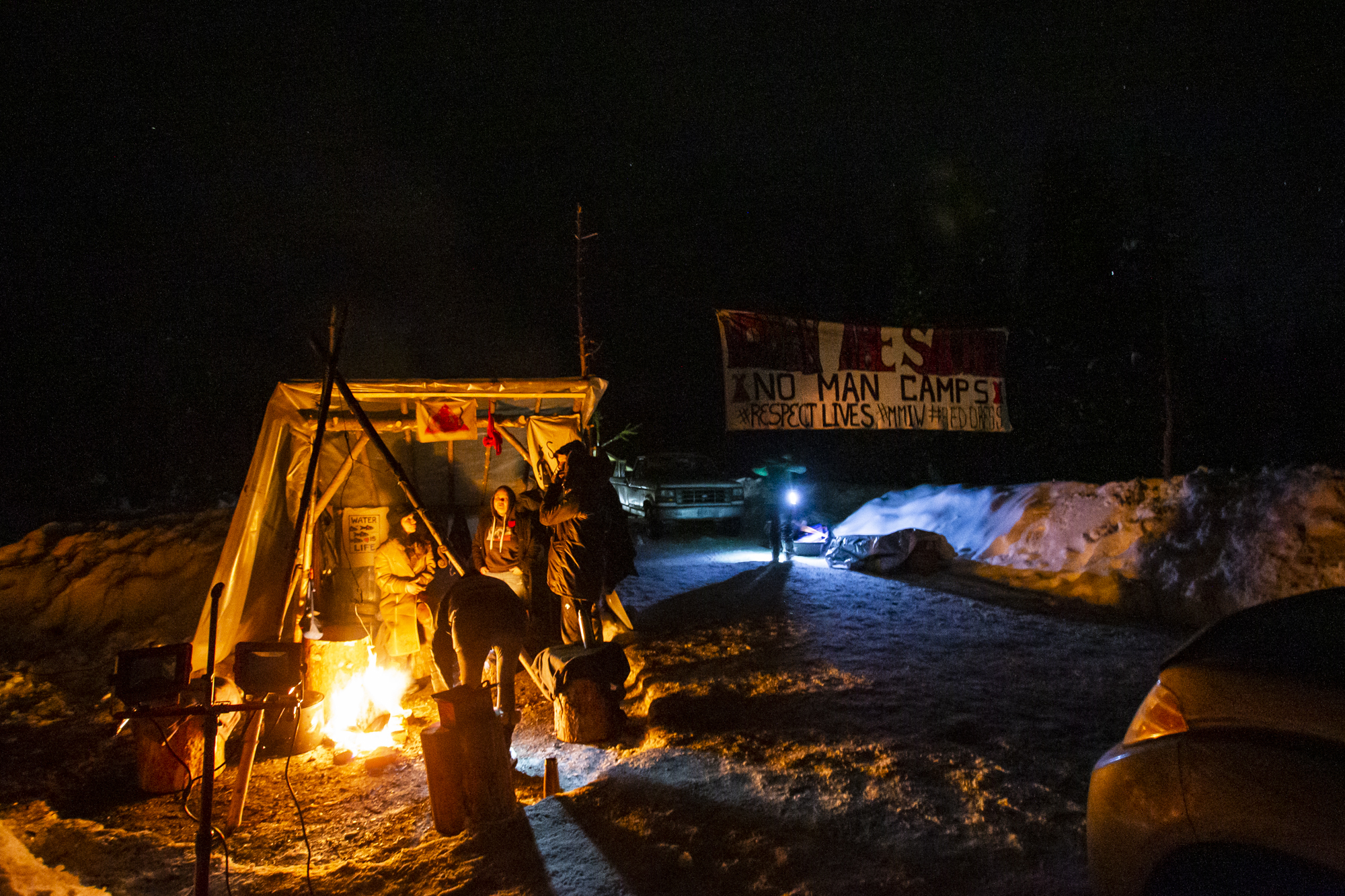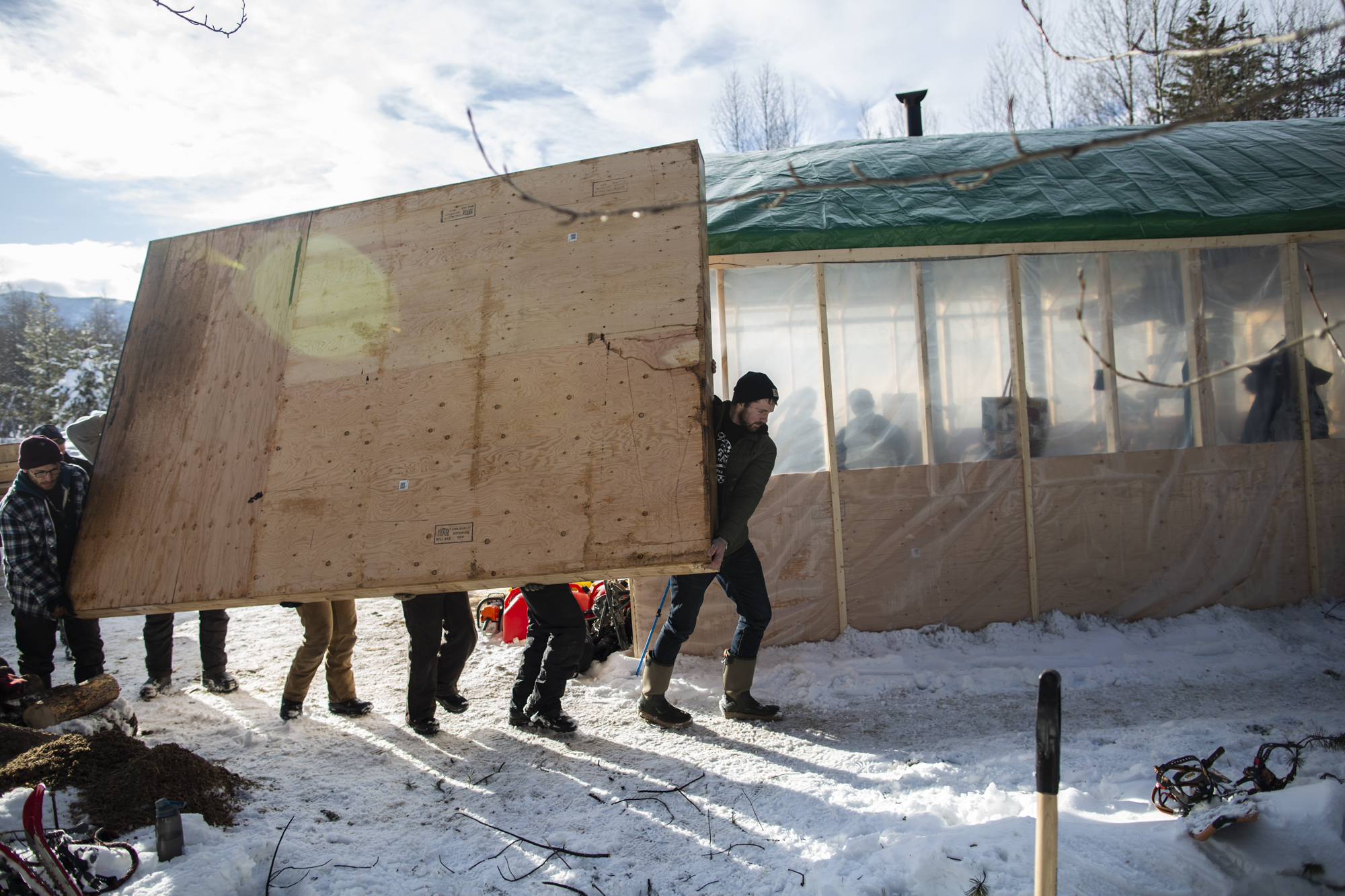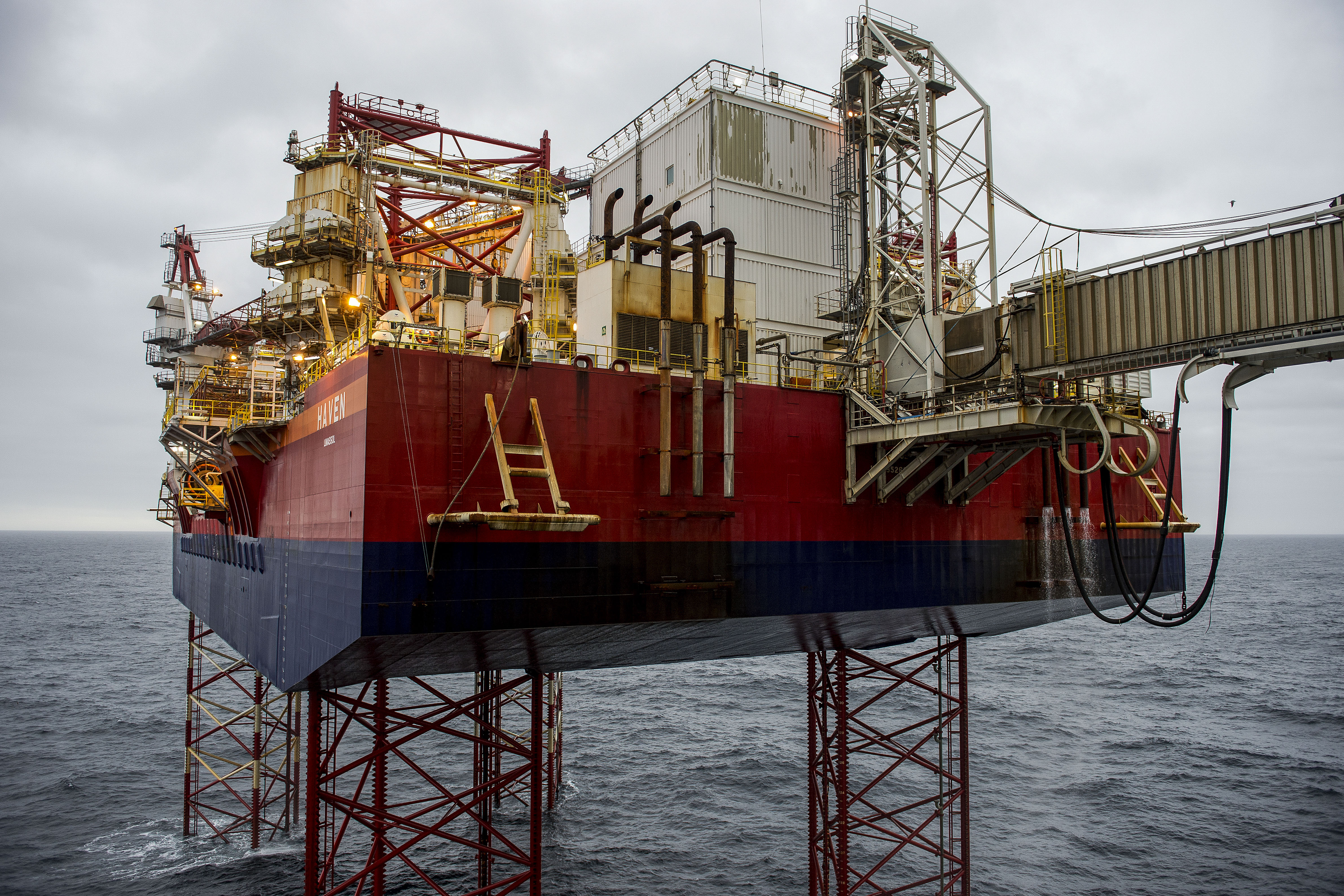Indigenous land defenders are keeping a close eye on cops as the standoff enters its fourth week.
By Jesse Winter Jan 28 2020

RCMP TURN AWAY A WET'SUWET'EN CAMP SUPPORTER AT A POLICE ROADBLOCK. ALL PHOTOS BY JESSE WINTER
A set of headlights came peering out of the darkness, accompanied by a rattling diesel engine.
Rising from beside a warming fire at a watch camp inside an RCMP roadblock, Sabina Dennis rushed to the road.
“Cops!” she shouted as the first RCMP officer’s boot hit the snowy ground. “Someone get a camera.” More people scrambled from the fire to join Dennis as a second officer got out of the truck. Someone started filming the interaction with a cellphone. Now that a standoff between RCMP and Wet’suwet’en First Nation land defenders who oppose a pipeline has entered a fourth week, the mood behind police lines is understandably tense.
“Hello, how’s everyone doing tonight?” the first officer asked gamely, walking forward with his arms at his sides, palms facing forward. “Everyone good? Anything you guys need?”
“Yeah, you off our territory,” said Cody Merriman, joining Dennis in the roadway.
“I can understand that,” the officer replied with a wry smile, as though his colleagues weren’t—at that moment—manning a roadblock limiting access to this very camp.
“No, like all the way out of our territory,” Merriman said, not laughing. The officers stopped approaching. After a few more words, they got back in their pickup truck and reversed slowly back down the road into the night.

"ALL THE WAY OUT OF OUR TERRITORY," CODY MERRIMAN TOLD TWO RCMP OFFICERS.
The watch camp where Dennis and Merriman are stationed was set up to monitor police movements along a roadway leading to more established Wet’suwet’en camps. The new roadblocks and checkpoints have become a sort of slow-moving chess game in a pipeline controversy that goes back nearly a decade.
Last January, militarized RCMP raided a blockade set up by the Gidimt’en clan of the Wet’suwet’en nation to prevent Coastal GasLink from building a natural gas pipeline through their traditional territory.
The company has agreements for access with all the First Nations band councils along the pipeline route, including those within the Wet’suwet’en Nation. But the Wet’suwet’en hereditary chiefs say the band councils do not have jurisdiction over the traditional territory outside the reserve boundaries and should not have agreed to the project.
During last year’s raid, police deployed tactical officers armed with assault and sniper rifles, at one point brandishing a chainsaw. The officers forced their way over barbed wire and a reinforced gate, amid the screams of land defenders, some of whom had chained themselves to the gate itself.

MOLLY WICKHAM AND HER PARTNER CODY MERRIMAN STAY WARM BY A FIRE AT A WET'SUWET'EN WATCH CAMP.
As the police left the watch camp Friday night, Dennis, Merriman, and the others returned to the fire and huddled around a cellphone, watching video from the aftermath of last year’s raid.
Among them was Gidimt’en clan spokesperson Sleydo, a.k.a. Molly Wickham. Together she and Dennis became the faces of last year’s police violence. Wickham herself was arrested.
Watching the year-old video in the flickering firelight, Wickham’s face is set hard. Dennis dashed tears from her eyes. Just over a year later, and it seems little has changed.
“It’s a weird feeling,” Wickham said, of seeing the video. Last year “I was still in this traumatic bubble of trying to regain my footing and make sure all of our people were safe.”
“I think we’re definitely more prepared this year, mentally, emotionally for what might happen,” she said. “It’s a good reminder of how much caution we have to take, and how much risk we are at in this position.”
On December 20, the Guardian published an explosive report alleging that the RCMP officers at the raid had pre-authorization to use snipers and “lethal overwatch.” One RCMP commander reportedly said to “use as much violence as you want” against the Gidimt’en gate.

LAND DEFENDERS SIT AROUND A FIRE KEEPING WATCH FOR POLICE ACTIVITY LATE INTO THE NIGHT.
In the wake of the bombshell story, the hereditary chiefs issued an eviction notice to Coastal GasLink, kicking the company off their land and blockading the road again. They demand meetings with the federal and provincial government decision-makers, triggering the current stalemate.
On Monday, B.C. Premier John Horgan announced the appointment of former Skeena-Bulkely Valley MP Nathan Cullen as an official liaison between the provincial government and the hereditary chiefs.
Wet’suwet’en hereditary Chief Na’Moks, also known as John Ridsdale, said Cullen’s work as the region’s member of parliament gives him more credibility than most politicians. “As you know, we have been wanting to meet with government decision-makers,” Na’Moks told VICE on Monday. “Nathan has lived on our territories. We trust him.”
Na’Moks said while Cullen’s appointment is a positive step forward, ultimately he expects it will only delay the inevitable. The only acceptable outcome for the hereditary chiefs, he said, is for Coastal GasLink to peacefully withdraw from his people’s territory.
That demand means the prospect of a repeat of last year’s raid still hangs over the heads of everyone on the front line.
“It’s unsettling, to be honest,” Merriman said, “but you have to stay steadfast.”

RCMP VEHICLES BLOCK THE ACCESS ROAD LEADING TO WET'SUWET'EN CAMPS.
“In the end, this is what victory looks like,” he said. “You remove the RCMP checkpoint and the CGL workers, and this is it. We govern the territories, and they’re industry-free sovereign zones, with an access point controlled by Indigenous people.”
Since the checkpoint went up, Wickham and Merriman have been doing the lion’s share of logistical work, ferrying supplies through the police lines to the watch camp and making sure everyone is safe. Juggling that while also raising a family together has put a lot of stress on both of them.
The RCMP roadblock isn’t making things easier, Merriman said.
“It’s trapped people back here (at the watch camp) because they’ve threatened to briefly detain anyone who leaves,” Merriman said, adding that anyone who does leave and isn’t on the RCMP’s list of approved travellers will not be allowed back in.
In response to the police checkpoint, Wet’suwet’en supporters are building a second watch camp with an insulated bunkhouse to keep a vigil and monitor police movements. It also serves as a meeting place for the hereditary chiefs, and a place for supporters to gather.

WET'SUWET'EN SUPPORTERS CARRY PRE-FABRICATED WALLS TO BUILD
A BUNKHOUSE NEAR THE RCMP ROADBLOCK.
It sits only a few hundred metres from the RCMP roadblock which—as far as the supporters monitoring the RCMP can tell—appears to be guarded 24 hours a day in rotating 12-hour shifts.
As the stalemate has dragged on, a sort of daily rhythm has developed. Supporters test the RCMP checkpoint every day, probing for inconsistencies in the various reasons police give for turning people away. Every interaction is recorded by legal observers compiling evidence for a legal complaint about the checkpoint infringing the rights of the Wet’suwet’en and anyone wishing to use the otherwise public road.
The RCMP respond with near-daily surveillance flights over the camps—something the force at first denied it was doing, but later recanted after photos emerged of a plane with RCMP logos making repeated circles over each of the land defender camps.
On Friday morning, lawyers Noah Ross and Irina Ceric ran a training session for legal observers, instructing a group of Wet’suwet’en supporters in how best to document and record police actions.

LAWYERS TEACH WET'SUWET'EN SUPPORTERS HOW TO BE LEGAL OBSERVERS.
After the training, Ross, Ceric, and two legal observers tried to get through the police roadblock. They were turned around because they didn’t have a forestry radio or winter tire chains.
The next day, with little change in the road conditions, two minivans full of supplies but without tire chains, radios or even all-wheel drive were allowed through the police roadblock.
While the uncertainty over what comes next hangs in the air, Saturday provided some relief with a community day at the supporter camp outside the police roadblock.

BREAKFAST AT THE WET'SUWET'EN SUPPORTER CAMP OUTSIDE THE POLICE CHECKPOINT.
Smogelgem, the hereditary chief of the Wet’suwet’en’s Laksamshu Clan (who is also known as Warner Naziel), thanked the neighbouring Gitxsan chiefs for their support and time despite the death of a national matriarch over the weekend. He spoke at length to the dozens of people in attendance, some of whom had driven hours to be at the event.
He spoke about the last piece of untouched Wet’suwet’en territory to have a road carved through it, the damage he says that road caused to local wildlife. He described Coastal GasLink as a soulless organization bent on profit alone, and the Kweese War Trail that Unist’ot’en supporters say was bulldozed through last winter.
“We are at war again,” he said, again referencing the Guardian article and its allegations of “lethal overwatch,” which has hung like a pall over the movement since it was published.

HEREDITARY CHIEF SMOGELGEM SPEAKS AT A COMMUNITY RALLY.
It’s also sparked protests and demonstrations across the province and the country. There have been highway roadblocks in Ontario, and teen activists arrested in provincial ministers’ offices in Victoria. On Monday, students in Vancouver staged a walkout.
Canada’s former justice minister Jody Wilson-Raybould recently weighed in with an op-ed parsing the complicated layers of history behind this decade long conflict.
As the afternoon wore on at the newest Wet’suwet’en camp, more supplies and donations were unloaded outside the roadblock, to be ferried up to the watch camp and onwards to the blockade further up the road.
The lines of this conflict are hardening, with no word yet on when—or how—it will end.







